
The Lamiaceae or Labiatae are a family of flowering plants commonly known as the mint or deadnettle or sage family. Many of the plants are aromatic in all parts and include widely used culinary herbs like basil, mint, rosemary, sage, savory, marjoram, oregano, hyssop, thyme, lavender, and perilla, as well as other medicinal herbs such as catnip, salvia, bee balm, wild dagga, and oriental motherwort. Some species are shrubs, trees, or, rarely, vines. Many members of the family are widely cultivated, not only for their aromatic qualities, but also their ease of cultivation, since they are readily propagated by stem cuttings. Besides those grown for their edible leaves, some are grown for decorative foliage. Others are grown for seed, such as Salvia hispanica (chia), or for their edible tubers, such as Plectranthus edulis, Plectranthus esculentus, Plectranthus rotundifolius, and Stachys affinis. Many are also grown ornamentally, notably coleus, Plectranthus, and many Salvia species and hybrids.

Leonotis is a genus of flowering plants in the family Lamiaceae. One species, Leonotis nepetifolia, is native to tropical Africa and southern India. It is naturalized throughout most of the tropics. The other species are endemic to southern + eastern Africa.

Stachys is one of the largest genera in the flowering plant family Lamiaceae. Estimates of the number of species in the genus vary from about 300, to about 450. The type species for the genus is Stachys sylvatica. Stachys is in the subfamily Lamioideae. Generic limits and relationships in this subfamily are poorly known.

Cephalanthus is a genus of flowering plants in the family Rubiaceae. There are about six species that are commonly known as buttonbush.

Vitex is a genus of flowering plants in the sage family Lamiaceae. It has about 250 species. Common names include chaste tree or chastetree, traditionally referring to V. agnus-castus but often applied to other species as well.
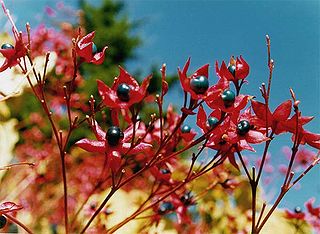
Clerodendrum is a genus of flowering plants formerly placed in the family Verbenaceae, but now considered to belong to the Lamiaceae (mint) family. Its common names include glorybower, bagflower and bleeding-heart. It is currently classified in the subfamily Ajugoideae, being one of several genera transferred from Verbenaceae to Lamiaceae in the 1990s, based on phylogenetic analysis of morphological and molecular data.
Cuphocarpus is an obsolete genus of flowering plants in the family Araliaceae. Mabberley (2008) treated it as a synonym of Polyscias, but other authors still recognized it at that time. In 2010, in a phylogenetic analysis of DNA sequences, it was shown that Cuphocarpus was biphyletic and embedded in the large genus Polyscias. In an accompanying paper, Polyscias was divided into 11 subgenera, with seven species left incertae sedis.
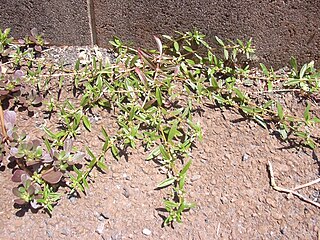
Oldenlandia is a genus of flowering plants in the family Rubiaceae. It is pantropical in distribution and has about 240 species. The type species for the genus is Oldenlandia corymbosa.

Guettarda is a plant genus in the family Rubiaceae. Most of these plants are known by the common name velvetseed. Estimates of the number of species range from about 50 to 162. Most of the species are neotropical. Twenty are found in New Caledonia and one reaches Australia. A few others are found on islands and in coastal areas of the Indian and Pacific Oceans.

Kohautia is a genus of flowering plants in the family Rubiaceae. They are native to tropical areas of Asia, Africa, and Madagascar. Thirty-one species are known. The type species for the genus is Kohautia senegalensis.

Rondeletia is a genus of flowering plants in the family Rubiaceae. It is endemic to the Neotropics. There are around 160 species.
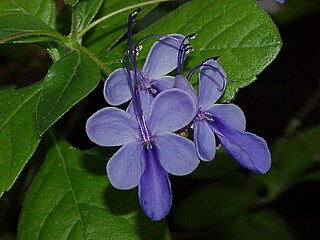
Rotheca is a genus of flowering plants in the family Lamiaceae. Estimates of the number of species in the genus vary from about 35 to as many as 60. Three of the species are native to tropical Asia, with the rest occurring in Sub-Saharan Africa. The type species for the genus is Rotheca serrata. It had originally been named Rotheca ternifolia, but this name is now considered illegitimate.
Hoplophyllum is a genus of flowering plants in the family Asteraceae. It has two species, Hoplophyllum spinosum and Hoplophyllum ferox, both native to South Africa.
Platycarpha is a genus of South African plants dandelion subfamily within the daisy family.

Hedyotis (starviolet) is a genus of flowering plants in the family Rubiaceae. Many species of this genus such as Hedyotis biflora, H. corymbosa and H. diffusa are well known medicinal plants. Hedyotis is native to tropical and subtropical Asia and to islands of the northwest Pacific. It comprises about 115 species. The type species for the genus is Hedyotis fruticosa.
Chione is a monotypic genus of flowering plants in the family Rubiaceae containing the single species Chione venosa. It is native to the neotropics, occurring in most of Mexico, and throughout Central America, the Caribbean, Colombia, Ecuador, and Peru. It is typically a tree growing 10 to 20 meters tall. In harsh habitats, it may be dwarfed and shrubby. It has no known economic use.
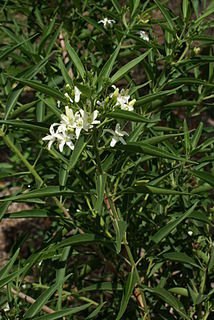
Clerodendrum heterophyllum is a species of flowering plant in the genus Clerodendrum of the family Lamiaceae. It is a native to Mauritius and La Réunion.
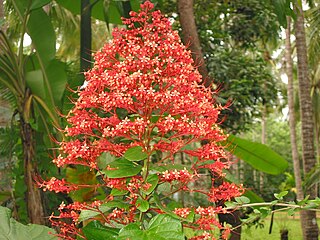
Clerodendrum paniculatum, the pagoda flower, is a species of flowering plant in the genus Clerodendrum and family Lamiaceae. It is native to tropical Asia and Papuasia, Fiji, French Polynesia, and Central America.
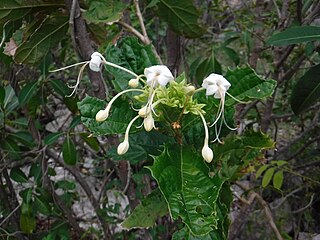
Ovieda is a genus of flowering plant in the family Lamiaceae, first described for modern science in 1753. It contains only one known species, Ovieda spinosa , endemic to the Island of Hispaniola in the West Indies.


















